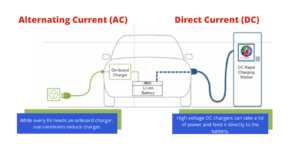The electric motor works on the interaction between the motor’s magnetic field and electric current. Which can be powered by a direct current (DC) source or by an alternating current (AC) source.

Type of Current an Electric Vehicle Use
We all know that an electric vehicle generally has an onboard rechargeable storage unit. Typically a lithium-ion battery that works as a source of power for an electric motor that brings the vehicle in motion. The electric vehicle mainly depends on batteries and motor used in it.
An electric vehicle generally comes with lithium-ion batteries which allow electricity to store in chemical form. Lithium-ion batteries have high power density, high energy density, and long life span as compared with others.
Motor EV is something that converts electrical energy from the batteries to mechanical energy. The motor transfers this mechanical energy to the wheels of electric vehicles and turns them through cogwheel. But what motor does an electric vehicle use.
Motor
This is the most important part of every electric vehicle. In Electric Vehicle AC or DC, any kind of motor can be used. Both have some advantages and some disadvantages.
AC Motor
AC motor or alternating current motor is a three-phase motor that is powered by 240 volts alternating current. Motors are widely used by EVs manufacturers particularly for high-performance vehicles. AV motors are further divided into two categories that are induction motor and synchronous motor.
Induction motors are the cost-effective, low maintenance, and reliable motor among these two. Tesla motor vehicles have induction motor within vehicles.
Synchronous motors are not like an induction motor in which the rotor turns at a slower speed than that of the magnetic field. In a synchronous motor both rotor and magnetic field turns at the same speed.
In AC installation any three-phase AC industrial motor can be used, which is convenient in terms of availability, motor size, shape, and power.
The most exciting feature of an AC motor is that it turns into a generator that delivers the power back to the batteries of an electric vehicle. But an electric car, bus, two-wheelers. And other vehicles, with AC motor, requires an inverter that converts DC to AC. Because of the source of power is a battery (battery supplies direct current), and motor require alternating current.
DC Motor
A direct current motor (DC) can run on anything between 96 to 192 volts. DC motors are further classified into three categories that are, brushed DC motor, brushless DC motor, and stepper.
Electric vehicle manufacturers widely use a brushed DC motor. DC motors are easy to install and are less expensive than an AC motor.
Read More:- Do Electric Vehicle Runs on AC or DC?

